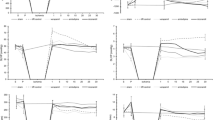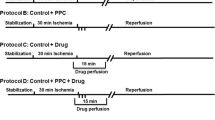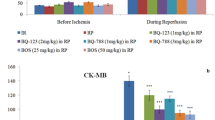Abstract
Catecholamines have been demonstrated to be cardiotoxic. Besides hemodynamic alterations, oxygen free radicals generated by the auto-oxidation of catecholamines might contribute to their deleterious effects. We examined the influence of exogenous norepinephrine (NE), after inhibiting functional alterations by alpha and beta-adrenoceptor blockade, on acute regional ischemia (MI). Method: We used isolated electrically-driven rabbit hearts with depleted catecholamine stores (reserpine 7.0 mg/kg i.p. 16–24 h before preparation, Langendorff, constant pressure: 70 cm H2O, Tyrode solution, Ca 2+ 1.8 mmol/l, 37°C, 185–200 beats/min). Repetitive MI, separated by a reperfusion period of 50 min, was induced by coronary artery branch ligature and quantitated from epicardial NADH-fluorescence photography. Starting after a reperfusion period of 20 min, isolated hearts were treated with NE (10−6 M), in the presence of propranolol (10−6 M), phentolamine (10−6 M) and vitamin C (3 × 10−8 M) in the perfusion buffer to prevent the functional effects of NE. The influence of the free radical scavenger superoxide dismutase (SOD) (30 U/ml) or captopril (10−6 M) on MI was also examined. Results: Left ventricular pressure or coronary flow were not significantly affected by either treatment (p>0.05). Epicardial NADH-fluorescence area and intensity were, however, significantly enhanced by NE (+ 22%) (P<0.05), although propranolol, phentolamine and vitamin C had no significant influence on MI (P>0.05). SOD had no significant effect on MI in control hearts (P> 0.05) but completely prevented MI enlargement by NE (P>0.05). Captopril did not significantly affect MI in control hearts and did not inhibit MI enlargement by NE (P<0.05). Conclusion: NE has deleterious effects .on MI in isolated rabbit hearts that are independent of functional alterations. This MI enlargement by NE is mediated by superoxide anion radicals since it could be prevented by SOD. Free radical scavenging properties reported for vitamin C, propranolol or captopril in several in-vitro systems are uneffective in preventing NE cardiotoxicity mediated by oxygen free radicals in isolated rabbit hearts.
Similar content being viewed by others
References
Baller D, Bretschneider HJ, Hellige G (1979) Validity of myocardial oxygen consumption parameters. Clin Cardiol 2:317–327
Becker BF, Reinholz N, Leipert B, Raschke P, Gerlach (1991) Sind Radikalfänger-Eigenschaften von ACE-Inhibitoren mit Sulfhydrylgruppen bei therapeutisch wirksamen Konzentrationen von quantitativer Bedeutung? Klin Wochenschr 69 (Suppl 24):6–9
Bindoli A, Rigobello MP, Galzigna L (1989) Toxicity of aminochromes. Toxciol Lett 48:3–20
Dhalla NS, Yates JC, Naimark B, Dhalla KS, Beamish RE, Ostadal B (1992) Cardiotoxicity of catecholamines and related agents. In: Acosta D Jr (ed) Cardiovascular toxicology. Raven Press, New York, pp 239–282
Ferrari R, Ceconi C, Curello S (1989) Superoxide dismutase: Possible therapeutic use in cardiovascular disease. Pharmacol Res 21 (Suppl 2):57–66
Ferrari R, Ceconi C, Curello S, Cargnoni A, Alfieri O, Pardini A, Marzollo A, Visioli O (1991) Oxygen free radicals and myocardial damage: Protective role of thiol-containing agents. Am J Med 81 (Supp 3C):95–105
Freeman BA, Crapo MD (1982) Biology of disease. Free radicals and tissue injury. Lab Invest 47:412–426
Halliwell B, Gutteridge JMC (1989) Free radicals in biology and medicine. Clarendon Press, Oxford
Hauge A, Oye I (1966) The action of adrenaline in cardiac muscle. II. Effect on oxygen consumption in the asystolic perfused rat heart Acta Physiol Scan 68:295–303
Karmazyn M, Beamish RE, Fliegel L, Dhalla NS (1981) Adrenochrome-induced coronary artery constriction in the rat heart. J Pharmacol Exp Ther 219:225–230
Langendorff O (1895) Untersuchungen am überlebenden Südugetierherzen. Arch Ges Physiol 61:291–332
Mak IT, Weglicki WB (1988) Protection by beta-blocking agents against free radical-mediated sarcolemmal lipid peroxidation. Circ Res 63:262–266
Mak IT, Arroyo CM, Weglicki WB (1989) Inhibition of sarcolemmal carbon-centered free radical formation by propranolol. Circ Res 65:1151–1156
Pi XJ, Chen X (1989) Captopril and ramiprilat protect against free radical injury in isolated working rat hearts. J Mol Cell Cardiol 21:1261–1271
Richardt G, Lumpp U, Haass M, Schömig A (1990) Propranolol inhibits nonexocytotic noradrenaline release in myocardial ischemia. Naunyn Schmiedebergs Arch Pharmacol 341:50–55
Rona G, Chappel CI, Balazs T, Gaudry R (1959a) An infarct-like myocardial lesion and other toxic manifestations produced by isoproterenol in the rat. Arch Pathol 67:443–455
Rona G, Zsoter T, Chappel C, Gaudry R (1959b) Myocardial lesions, circulatory and electrocardiographic changes produced by isoproterenol in the dog. Rev Can Biol 18:83–94
Rona G, Kahn DS, Chappel CI (1963) Studies on infarct-like myocardial necrosis produced by isoproterenol: a review. Rev Can Biol 22:241–255
Rump AFE, Rösen R, Klaus W (1993a) Cardioprotection by superoxide dismutase: A catecholamine-dependent process? Anest Analg 76:239–246
Rump AFE, Korth A, Rösen R, Klaus W (1993b) Deleterious effect of exogenous angiotensin-I on the extent of regional ischemia and its inhibition by captopril. Eur Heart J 14:106–112
Rump AFE, Blazincic B, Klaus W (1993c)Effect of amrinone and mirinone on myocardial ischemia extent and infarct size in isolated rabbit hearts. Arzneim Forsch 43:1262–1266
Schömig A, Kurz T, Richardt G, Schömig E (1988) Neuronal sodium homeostasis and axoplasmic amine concentrations determine calcium-independent noradrenaline release in normoxic and ischemic rat heart. Circ Res 63:214–226
Shaw TRD, Duncan FM, Williams BC, Crichton E, Thomson SA, Davis JRE, Rademaker M, Edwards CRW (1985) Plasma free captopril concentrations during short and long term treatment with oral captopril for heart failure. Br Heart J 54:160–165
Singal PK, Kapur N, Dhillon (1982) Role of free radicals in catecholamine-induced cardiomyopathy. Can J Physiol Pharmacol 60:1390–1397
Sobel B, Jequier E, Sjoerdsma A, Lovenberg W (1966) Effect of catecholamines and adrenergic blocking agents on oxidative phosphorilation in rat heart mitochondria. Circ Res 19:1050–1061
Weglicki WB, Mak IT, Simic MG (1990) Mechanisms of cardiovascular drugs as antioxidants. J Mol Cell Cardiol 22:1199–1208
Westin W, Mullane K (1988) Does captopril attenuate reperfusion-induced myocardial dysfunction by scavenging free radicals. Circulation 77 (Suppl I):I30-I39
Yates JC, Dhalla NS (1975) Induction of necrosis and failure in the isolated perfused rat heart with oxidized isoproterenol. J Mol Cell Cardiol 7:807–816
Author information
Authors and Affiliations
Additional information
Correspondence to: A.F.E. Rump at the above address
Rights and permissions
About this article
Cite this article
Rump, A.F.E., Klaus, W. Evidence for norepinephrine cardiotoxicity mediated by superoxide anion radicals in isolated rabbit hearts. Naunyn-Schmiedeberg's Arch Pharmacol 349, 295–300 (1994). https://doi.org/10.1007/BF00169296
Received:
Accepted:
Issue Date:
DOI: https://doi.org/10.1007/BF00169296




